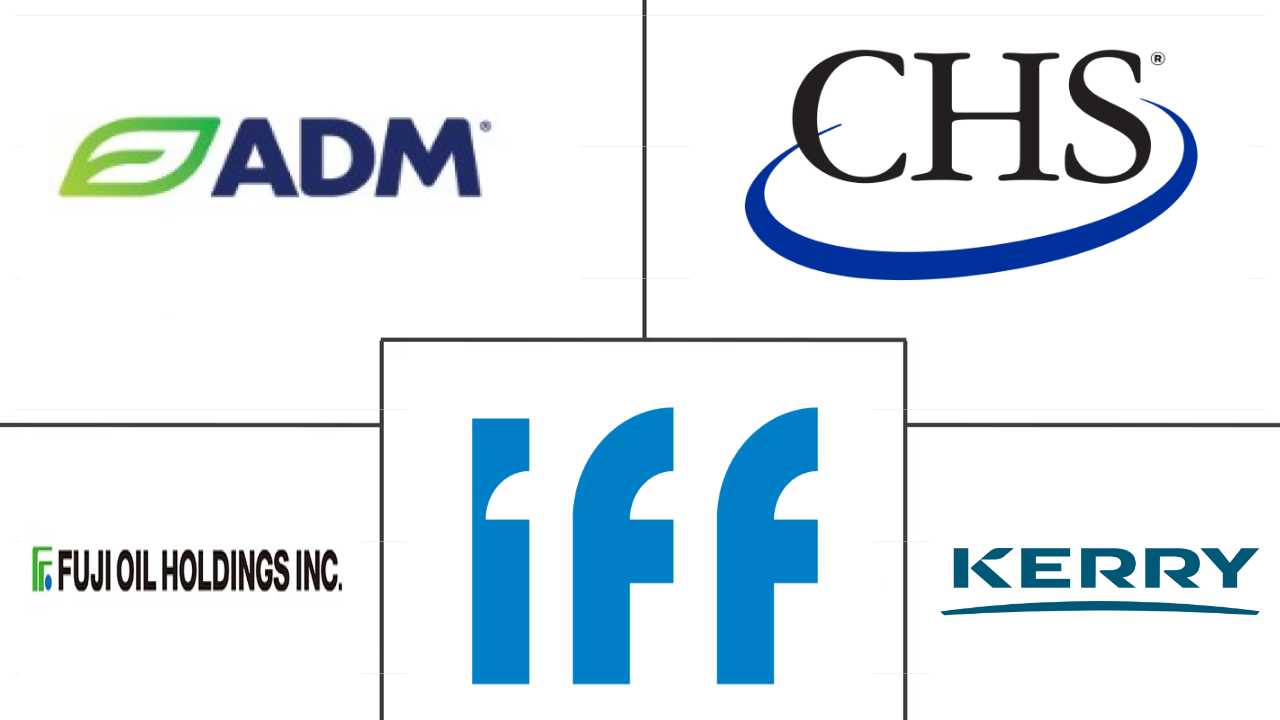Market Size of soy protein Industry
| Icons | Lable | Value |
|---|---|---|
|
|
Study Period | 2017 - 2029 |
|
|
Market Size (2024) | USD 10.49 Billion |
|
|
Market Size (2029) | USD 13.26 Billion |
|
|
Largest Share by End User | Animal Feed |
|
|
CAGR (2024 - 2029) | 4.80 % |
|
|
Largest Share by Region | North America |
|
|
Market Concentration | Low |
Major Players |
||

|
||
|
*Disclaimer: Major Players sorted in no particular order |
Soy Protein Market Analysis
The Soy Protein Market size is estimated at 10.49 billion USD in 2024, and is expected to reach 13.26 billion USD by 2029, growing at a CAGR of 4.80% during the forecast period (2024-2029).
10.49 Billion
Market Size in 2024 (USD)
13.26 Billion
Market Size in 2029 (USD)
4.97 %
CAGR (2017-2023)
4.80 %
CAGR (2024-2029)
Largest Market by Form
46.14 %
value share, Isolates, 2023
Soy protein isolates overpower other forms due to their low viscosity and high dispersibility and solubility, which cater to their extensive application in all sectors.
Largest Market by End User
50.33 %
value share, Animal Feed, 2023
Soy proteins are widely used in the animal feed segment due to their distinct benefits like protein digestibility, appropriate amino acid profile, extended shelf life, etc.
Fastest Growing Market by Form
4.87 %
Projected CAGR, Isolates, 2024-2029
Constant innovations played an extremely important role in boosting the sales value of SPIs, globally. Recently, organically sourced SPIs have been capturing the market.
Fastest Growing Market by End User
6.31 %
Projected CAGR, Supplements, 2024-2029
The rising consumer focus on health and sports fitness is anticipated to drive the segment. The preference for soy in the segment is propelling segmental growth.
Leading Market Player
11.66 %
market share, International Flavors & Fragrances Inc., 2021

IFF is constantly expanding in soy proteins segment, and its differentiated product portfolio is the most important factor in its success.
The suitability of soy-protein due to its easier digestibility factor dominated it's application mainly in Animal feed sector
- The usage of soy protein ingredients in animal feed marginally surpasses its usage in food and beverages. Soy protein, mainly in the form of concentrates, is widely used in the diets of animals, birds, and fish. Its main characteristics, such as easy digestibility, improved shelf life, and protein enrichment, are driving its application in the food and beverage segment. In 2022, the animal feed segment was largely driven by concentrates that addressed about 55% of soy protein needs.
- Food and beverage is another crucial application sector for soy protein, mainly in the meat/meat alternative segment, attributed to multi-functionalities that mimic muscle texture when stacked in straight fibers, thus, improving its use for texture and protein enrichment in meat alternatives. In 2022, the meat alternatives sub-segment accounted for about 22% of the soy protein market. In terms of growth, supplements remained the fastest-growing sector, with a projected CAGR of 5.95% by volume during the forecast period, attributed to the growing number of fitness enthusiasts in developed economies like the United States, the United Kingdom, and Germany.
- The supplements segment did not contribute significantly to the soy protein market. However, it is anticipated to see sizable growth in the coming years, recording a CAGR of 4.62% by volume during the forecast period. The development of the segment will be driven by the rising consumption of soy proteins in baby food and infant formula (2023-2029: projected CAGR of 4.03% by volume). Infants' appropriate growth and development are ensured by soy protein formulas. Isolated soy protein has the same PDCAAS score as milk protein and egg white, which is 1.0, the highest value obtained protein.
Increasing demand of cost-effective protein products lead the demand dominated by North America followed by Asia-pacific regions
- North America dominated the soy protein market, with most of its applications in the food and beverages segment. Meat and dairy alternatives led the market demand, holding a volume share of 44% in 2022. This growth can be attributed to the increasing demand for plant-based products, especially in the United States and Canada, which had a combined vegan population of about 10 million in 2021. Being among the largest producers of soybeans, the United States widely contributes to the regional soy protein demand. In 2021, soybean production totaled a record-high 4.44 billion bushels, up by 5% from 2020.
- North America is followed by the Asia-Pacific region. China remained the largest consumer of soy protein in the region, attributed to high production capacity that reduces the ingredient's price and boosts volume consumption. About 70% of the world’s supply of soy protein isolates, a primary ingredient in many plant-based foods, is processed in the Shandong province in China. This factor also enables immense innovation in plant-based space, attracting more consumers to try the differentiated product offerings. The region is projected to record a CAGR of 5.67% by value during the forecast period.
- South America is projected to be the fastest-growing market as the demand for natural and sustainable ingredients is rapidly increasing due to the rising health consciousness. The region is set to record a CAGR of 6.0% by value over the forecast period. Over the last few years, concerns about damage to the environment and unethical treatment of animals in intensive farming systems have increased among consumers, leading to increased demand for sustainable protein. This factor has led to the rising demand for plant proteins in most South American countries.
Soy Protein Industry Segmentation
Concentrates, Isolates, Textured/Hydrolyzed are covered as segments by Form. Animal Feed, Food and Beverages, Supplements are covered as segments by End User. Africa, Asia-Pacific, Europe, Middle East, North America, South America are covered as segments by Region.
- The usage of soy protein ingredients in animal feed marginally surpasses its usage in food and beverages. Soy protein, mainly in the form of concentrates, is widely used in the diets of animals, birds, and fish. Its main characteristics, such as easy digestibility, improved shelf life, and protein enrichment, are driving its application in the food and beverage segment. In 2022, the animal feed segment was largely driven by concentrates that addressed about 55% of soy protein needs.
- Food and beverage is another crucial application sector for soy protein, mainly in the meat/meat alternative segment, attributed to multi-functionalities that mimic muscle texture when stacked in straight fibers, thus, improving its use for texture and protein enrichment in meat alternatives. In 2022, the meat alternatives sub-segment accounted for about 22% of the soy protein market. In terms of growth, supplements remained the fastest-growing sector, with a projected CAGR of 5.95% by volume during the forecast period, attributed to the growing number of fitness enthusiasts in developed economies like the United States, the United Kingdom, and Germany.
- The supplements segment did not contribute significantly to the soy protein market. However, it is anticipated to see sizable growth in the coming years, recording a CAGR of 4.62% by volume during the forecast period. The development of the segment will be driven by the rising consumption of soy proteins in baby food and infant formula (2023-2029: projected CAGR of 4.03% by volume). Infants' appropriate growth and development are ensured by soy protein formulas. Isolated soy protein has the same PDCAAS score as milk protein and egg white, which is 1.0, the highest value obtained protein.
| Form | |
| Concentrates | |
| Isolates | |
| Textured/Hydrolyzed |
| End User | ||||||||||||
| Animal Feed | ||||||||||||
| ||||||||||||
|
| Region | |||||||||||||||||
| |||||||||||||||||
| |||||||||||||||||
| |||||||||||||||||
| |||||||||||||||||
| |||||||||||||||||
|
Soy Protein Market Size Summary
The soy protein market is experiencing significant growth, driven by its diverse applications in animal feed and the food and beverage industry. Soy protein, particularly in the form of concentrates, is extensively used in animal diets due to its digestibility and protein enrichment properties. In the food and beverage sector, soy protein is increasingly utilized in meat and dairy alternatives, offering texture and nutritional benefits that cater to the rising demand for plant-based products. The market is also witnessing a surge in the supplements segment, fueled by the growing health consciousness and fitness trends in developed regions. The demand for soy protein in baby food and infant formula is further contributing to market expansion, as it supports infant growth and development.
Regionally, North America leads the soy protein market, with a strong focus on food and beverage applications, particularly in meat and dairy alternatives. The United States, a major soybean producer, plays a crucial role in meeting regional demand. The Asia-Pacific region, with China as a key player, is also significant due to its high production capacity and innovation in plant-based foods. South America is emerging as the fastest-growing market, driven by increasing health awareness and demand for sustainable ingredients. Globally, the shift towards plant-based diets, influenced by environmental, ethical, and health concerns, is creating opportunities for soy protein manufacturers to innovate and expand their product offerings. The market remains fragmented, with major companies like Archer Daniels Midland Company and Fuji Oil Group leading the way in plant-based food solutions.
Soy Protein Market Size - Table of Contents
-
1. MARKET SEGMENTATION (includes market size in Value in USD and Volume, Forecasts up to 2029 and analysis of growth prospects)
-
1.1 Form
-
1.1.1 Concentrates
-
1.1.2 Isolates
-
1.1.3 Textured/Hydrolyzed
-
-
1.2 End User
-
1.2.1 Animal Feed
-
1.2.2 Food and Beverages
-
1.2.2.1 By Sub End User
-
1.2.2.1.1 Bakery
-
1.2.2.1.2 Beverages
-
1.2.2.1.3 Breakfast Cereals
-
1.2.2.1.4 Condiments/Sauces
-
1.2.2.1.5 Dairy and Dairy Alternative Products
-
1.2.2.1.6 Meat/Poultry/Seafood and Meat Alternative Products
-
1.2.2.1.7 RTE/RTC Food Products
-
1.2.2.1.8 Snacks
-
-
-
1.2.3 Supplements
-
1.2.3.1 By Sub End User
-
1.2.3.1.1 Baby Food and Infant Formula
-
1.2.3.1.2 Elderly Nutrition and Medical Nutrition
-
1.2.3.1.3 Sport/Performance Nutrition
-
-
-
-
1.3 Region
-
1.3.1 Africa
-
1.3.1.1 By Form
-
1.3.1.2 By End User
-
1.3.1.3 By Country
-
1.3.1.3.1 Nigeria
-
1.3.1.3.2 South Africa
-
1.3.1.3.3 Rest of Africa
-
-
-
1.3.2 Asia-Pacific
-
1.3.2.1 By Form
-
1.3.2.2 By End User
-
1.3.2.3 By Country
-
1.3.2.3.1 Australia
-
1.3.2.3.2 China
-
1.3.2.3.3 India
-
1.3.2.3.4 Indonesia
-
1.3.2.3.5 Japan
-
1.3.2.3.6 Malaysia
-
1.3.2.3.7 New Zealand
-
1.3.2.3.8 South Korea
-
1.3.2.3.9 Thailand
-
1.3.2.3.10 Vietnam
-
1.3.2.3.11 Rest of Asia-Pacific
-
-
-
1.3.3 Europe
-
1.3.3.1 By Form
-
1.3.3.2 By End User
-
1.3.3.3 By Country
-
1.3.3.3.1 Belgium
-
1.3.3.3.2 France
-
1.3.3.3.3 Germany
-
1.3.3.3.4 Italy
-
1.3.3.3.5 Netherlands
-
1.3.3.3.6 Russia
-
1.3.3.3.7 Spain
-
1.3.3.3.8 Turkey
-
1.3.3.3.9 United Kingdom
-
1.3.3.3.10 Rest of Europe
-
-
-
1.3.4 Middle East
-
1.3.4.1 By Form
-
1.3.4.2 By End User
-
1.3.4.3 By Country
-
1.3.4.3.1 Iran
-
1.3.4.3.2 Saudi Arabia
-
1.3.4.3.3 United Arab Emirates
-
1.3.4.3.4 Rest of Middle East
-
-
-
1.3.5 North America
-
1.3.5.1 By Form
-
1.3.5.2 By End User
-
1.3.5.3 By Country
-
1.3.5.3.1 Canada
-
1.3.5.3.2 Mexico
-
1.3.5.3.3 United States
-
1.3.5.3.4 Rest of North America
-
-
-
1.3.6 South America
-
1.3.6.1 By Form
-
1.3.6.2 By End User
-
1.3.6.3 By Country
-
1.3.6.3.1 Argentina
-
1.3.6.3.2 Brazil
-
1.3.6.3.3 Rest of South America
-
-
-
-
Soy Protein Market Size FAQs
How big is the Global Soy Protein Market?
The Global Soy Protein Market size is expected to reach USD 10.49 billion in 2024 and grow at a CAGR of 4.80% to reach USD 13.26 billion by 2029.
What is the current Global Soy Protein Market size?
In 2024, the Global Soy Protein Market size is expected to reach USD 10.49 billion.

